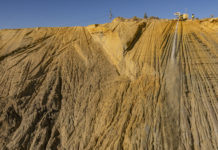
[miningmx.com] – INVESTING in South Africa’s junior mining sector is best left to the professionals owing to the highly speculative and risky nature that’s involved in searching for tomorrow’s minerals. There’s a number of reasons for that.
Mineral exploration is never quick; it is riddled with unknowns, and the companies that are involved in it are always one bad winter away from insolvency.
Even companies with good projects can end up victim to a bad market such as now when the world is long metals and demand and capital has fallen badly away.
And if any further evidence is required, not even the professionals fancy South African exploration shares much. According to Peter Major, a mining policy consultant for Cadiz Corporate Solutions, exploration companies aren’t to be trusted in the main.
He responded to a question at the recent Junior Indaba conference in Johannesburg as to why start-up exploration firms always did so badly by making the facetious remark: “Junior haven’t failed. Juniors milk the suckers’.
The evidence in terms of JSE performance is not overwhelming either.
A quick scan of the JSE stocks pages shows that in the current market, a slew of exploration and development firms have required urgent recapitalisation: Coal of Africa, Waterberg Coal Company, Miranda Minerals, all in coal. Whilst others such as Tawana Resources and Bauba Exploration had changed management or focus, or both.
So why bother?
Well, when exploration companies do find something, in the right market, the returns can be stratospheric.
Eland Platinum sold its prospect to Xstrata for $1bn. Australian listed Riversdale sold its coking coal prospect to Rio Tinto and Indian conglomerate Tata, for $4bn, whilst the successes of the world’s best known mining entrepreneur, Robert Friedland, who discovered the Voisey’s Bay nickel deposit in Canada and sold it to Inco for $3.1bn.
There’s also good reasons why an economy needs junior mining, especially in South Africa where there’s a strong history of mineral activity and a current need for job creation.
According to industry commentators, however, there are too many historical, regulatory and industry obstacles preventing the take-off of junior exploration firms.
South Africa’s history of corporate conglomeration – Anglo American and Gencor for instance – means investors don’t really have much of a track-record with exploration firms; they’re more familiar with strongly capitalised big players that either conduct their own exploration, or buy up juniors with good prospects.
Paul Miller, a resources banker at Nedbank Capital, says it’s also worth noting that more exploration companies sit outside the Chamber of Mines than within it, whilst SAMDA, an organisation established specifically for junior mining, has fallen into disrepair.
Worst, though, are the regulatory headwinds.
According to Otsile Matlou, a director at attorneys ENSafrica, the current regulatory framework has been designed for existing mining companies, not for mines that will exist in the future.
“Exploration companies have to deal with 203 different statutes which for them is like starting at technical non-compliance even before you start,’ said Matlou. “There would be benefit from the development of bespoke rules that only speaks to that industry.’
Regulatory uncertainty with empowerment rules in South Africa isn’t helping. “The risk profile of South Africa has increased because of everything that has happened,’ said Sacha Beukes, a senior investment officer at the IFC, the finance arm of the World Bank.
Perhaps the most damning of all statements was uttered by Miller who commented on the sinister side of government relations. “You have to take your battery out your cellphone because they’re suspicious you might record meetings with your own company,’ he said.
“You have to meet people in hotels in Midrand to resolve prospecting right disputes. You have to go to Middelburg to speak to people in coffee shops because there’s a back door to the department,’ he said.











